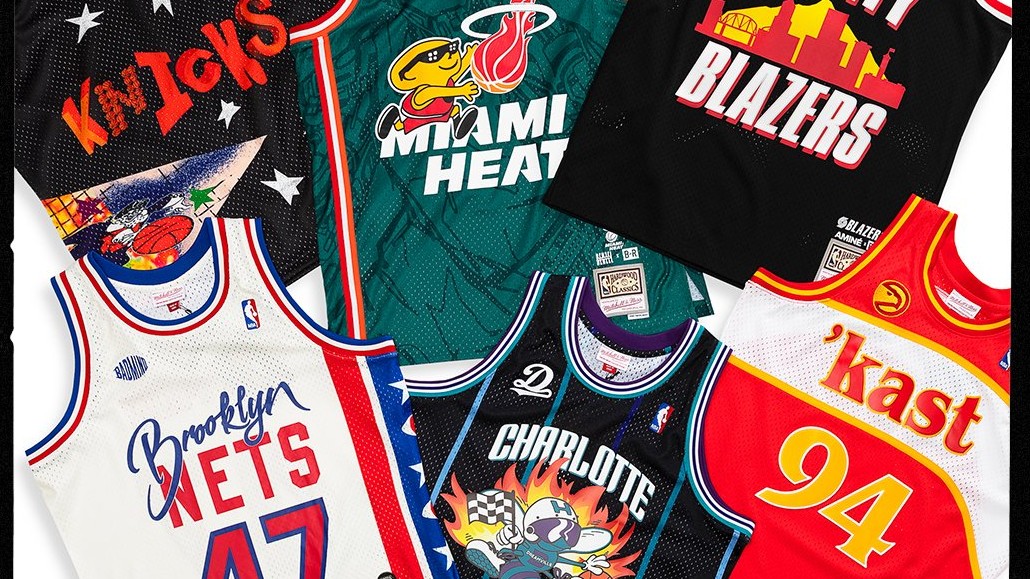Save 50% on a 3-month Digiday+ membership. Ends Dec 12.
Bleacher Report is drafting a commerce strategy that’s growth plan hinges on fan fervor for exclusive merchandise

Mark Bleacher Report down as yet another publisher pivoting hard in an attempt to ride the e-commerce wave through, and past, the present coronavirus-induced revenue generation and programming turbulence.
And fans will be the key, according to Bleacher Report’s and Turner Sports’ head of marketplace image and monetization, Ed Romaine, who said “fans [are] hungry to be connected to the player’s they love,” and are spending money to show their dedication.
And thanks to a partnership with the NBA and NFL Players’ associations — which gives B/R the rights to sell products with players’ names, image and likeness, as of earlier this year — the publisher has been able to dive further into creating product lines that fans of virtually any player would be interested in buying.
Bleacher Report’s e-commerce business, which accounted for 10% of the brand’s revenue at the start of the year, is pacing towards 25% growth year-over-year from 2019 to 2020, according to the company. Romaine would not disclose exactly how much revenue comes from that business line, but prices in the shop range from $25 for a t-shirt to $250 for a basketball jersey. B/R’s base of new customers has grown by 40% in 2020 alone, per the company.
The driver of B/R’s e-commerce operation is its Bleacher Report Shop that houses its limited edition apparel collections that are often tied to significant events in the world of professional sports.
In 2019, B/R had 10 collection drops, while this year that number increased to 15. One such collection is NBA Remix line, which features clothing with logos of eight NBA teams that had been artistically redesigned by hip hop artists based in the same city. Other collections combine artist designs that are meant to keep the products that B/R sells true to its brand voice and differentiated from the other sports merchandise that is available.
To secure the rights with the NBA and NFL Players Associations, Bleacher Report has a minimum guarantee deal requiring it sell a certain amount of merchandise in a year, with a percentage of sales going back to those organizations. The plan is to increase the number of collections and drops in 2021 that will not only feature All Star talent, but highly anticipated incoming prospects as well to widen the funnel of fans who are buying the merchandise.
“While we believe that digital media brands launching shops is a natural and logical evolution as they work to best engage and delight their audience — as well as diversify their business and make more money — they have to do it in fun and interesting ways. You have to have fun with it,” said Chris Erwin, founder of commerce consulting firm Rockwater.
Similar to this, Erwin said, is Complex’s ComplexCon, which not only brings together several hundred retailers, but uses the opportunity to release product collaborations that drive consumers to spend hundreds of dollars just to get in the door early. Publishers’ e-commerce operations have to be run in “unique ways that align with the values of their brands and shows that they know what their audiences want,” he said.
There are a mix of evergreen products in the B/R Shop that are replenished on an on-demand basis. But a few of the collections operate on the “drop” model to create hype around the product. But unlike the drop model that Nike uses to sell limited runs of highly anticipated sneakers — or shopping platform NTWRK uses to create hype around a unique product — B/R thinks about the timeliness of commerce and tying collections to sport events like the NFL Draft, the Super Bowl or the NBA All Star Game.
The e-commerce business started as an engagement play with fans, said Romaine, and as way to form deeper relationships with athletes and artists by collaborating with them on the products in the B/R Shop.
But overtime — as B/R becomes more integrated in the WarnerMedia sports portfolio and finds ways to integrate the Shop into more of the owned-and -operated platforms — there is the potential that this business becomes a primary revenue stream.
One instance where on-site promotion shows a promising area of growth is in the lower-third banners that are displayed during the game coverage. When the merchandise is promoted in those ad spots, Romaine said there is a surge in sales.
E-commerce “won’t supersede advertising revenue,” Romaine said. But, he added, “we haven’t even scratched the surface for how meaningful commerce can be as a business.”
“One of the most surprising parts about creating this business in the first place was we didn’t know if people were going to want to come to B/R for anything behind highlights and scores,” but not only have these first couple dozen collections proven that people will buy the merchandise, but it has also proven that artists and players are comfortable and excited about working with the publisher to produce unique clothing, Romaine said.
“Until we take full advantage of the resources at our disposal, we won’t know just how powerful commerce can be,” he said.
More in Media

As big brands flood the podcast ad space, startups are refining strategies to stand out
While a influx of big advertisers is good news for podcast companies, it also makes it more challenging for small- to mid-sized brands to stand out in the space.

Meta enters AI licensing fray, striking deals with People Inc., USA Today Co. and more
The platform has secured seven multi-year deals with publishers including CNN, Fox News, People Inc., USA Today Co to incorporate their content into its large language model (LLM) Llama.

European publishers say the Digital Omnibus ‘cookie fix’ leaves them worse off
The European Union’s attempt at a legislative spring clean for Europe’s web of data privacy rules, has landed flat with publishers.








